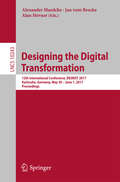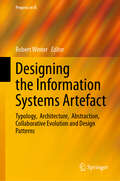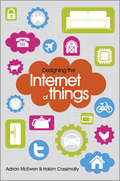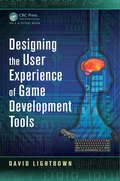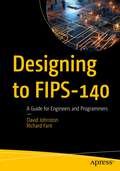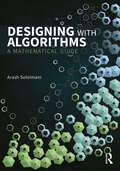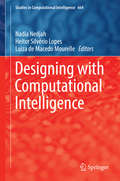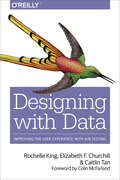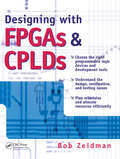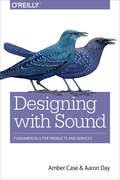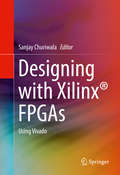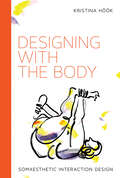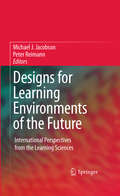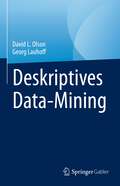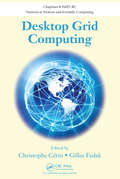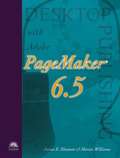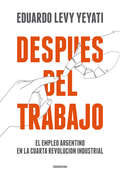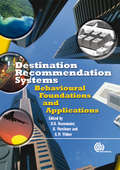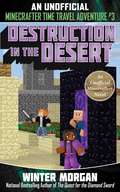- Table View
- List View
Designing the Digital Transformation: 12th International Conference, DESRIST 2017, Karlsruhe, Germany, May 30 – June 1, 2017, Proceedings (Lecture Notes in Computer Science #10243)
by Alexander Maedche, Jan vom Brocke and Alan HevnerThis book constitutes the proceedings of the 12th International Conference on Design Science Research in Information Systems and Technology, DESRIST 2017, held in May/June 2017 in Karlsruhe, Germany. The 25 full and 11 short papers presented in this volume were carefully reviewed and selected from 66 full and 19 short papers. The contributions are organized in topical sections named: DSR in business process management; DSR in human computer interaction; DSR in data science and business analytics; DSR in service science; methodological contributions; domain-specific DSR applications; emerging themes and new ideas; and products and prototypes.
Designing the Information Systems Artefact: Typology, Architecture, Abstraction, Collaborative Evolution and Design Patterns (Progress in IS)
by Robert WinterThis book provides essential methodological guidance on IS artifacts to address key challenges in Design Science Research (DSR). As a foundation for understanding and categorizing DSR artifacts, it proposes a more differentiated, empirically justified DSR artifact typology. Additionally, it presents an artifact type-agnostic architecture model for DSR project knowledge, offering concrete recommendations for researchers and practitioners alike. As most DSR artifacts exist on a wide range of abstraction levels, an artifact type-agnostic perspective of abstraction is presented and a set of fundamental generalization and contextualization operations is proposed. The concept of managed evolution and insights from tension theory are used to propose a collaboration model, fostering effective interaction between researchers and practitioners in DSR. Finally, by associating empirically validated classes of functional requirements with solution classes, candidates for general constructional patterns are developed. All chapters share a contemporary understanding of DSR artifacts as complex combinations of IT, organizational, and use elements – ranging from algorithms to informal interventions in organizations. These artifacts are based on both descriptive knowledge and empirical justifications (or ideally both) and are exemplified by contextualized instantiations that solve situated problems in organizations or administrations. This book provides a unified and practical approach to advancing DSR, offering insights for both advanced academic researchers and industry practitioners whose work involves IS artifacts.
Designing the Internet of Things
by Adrian Mcewen Hakim CassimallyTake your idea from concept to production with this unique guideWhether it's called physical computing, ubiquitous computing, or the Internet of Things, it's a hot topic in technology: how to channel your inner Steve Jobs and successfully combine hardware, embedded software, web services, electronics, and cool design to create cutting-edge devices that are fun, interactive, and practical. If you'd like to create the next must-have product, this unique book is the perfect place to start.Both a creative and practical primer, it explores the platforms you can use to develop hardware or software, discusses design concepts that will make your products eye-catching and appealing, and shows you ways to scale up from a single prototype to mass production.Helps software engineers, web designers, product designers, and electronics engineers start designing products using the Internet-of-Things approach Explains how to combine sensors, servos, robotics, Arduino chips, and more with various networks or the Internet, to create interactive, cutting-edge devices Provides an overview of the necessary steps to take your idea from concept through productionIf you'd like to design for the future, Designing the Internet of Things is a great place to start.
Designing the User Experience of Game Development Tools
by David LightbownMost tools developers want to improve the user experience but are not given the time, lack the techniques, or don't know where to begin.Designing the User Experience of Game Development Tools addresses these issues to empower tools developers to make positive steps toward improving the user experience of their tools.The book explains how to im
Designing to FIPS-140: A Guide for Engineers and Programmers
by David Johnston Richard FantThis book provides detailed and practical information for practitioners to understand why they should choose certification. It covers the pros and cons, and shows how to design to comply with the specifications (FIPS-140, SP800 documents, and related international specs such as AIS31, GM/T-0005-2021, etc.). It also covers how to perform compliance testing. By the end of the book, you will know how to interact with accredited certification labs and with related industry forums (CMUF, ICMC). In short, the book covers everything you need to know to make sound designs.There is a process for FIPS-140 (Federal Information Processing Standard) certification for cryptographic products sold to the US government. And there are parallel certifications in other countries, resulting in a non-trivial and complex process. A large market of companies has grown to help companies navigate the FIPS-140 certification process. And there are accredited certification labs you must contract toget the certification.Although this was once a fairly niche topic, it is no longer so. Other industries—banking, military, healthcare, air travel, and more—have adopted FIPS certification for cryptographic products. The demand for these services has grown exponentially. Still, the available skills pool has not grown. Many people are working on products with zero usable information on what to do to meet these standards and achieve certification or even understand if such certification applies to their products. What You Will Learn What is FIPS-140? What is the SP800 standard?What is certification? What does it look like? What is it suitable for?What is NIST? What does it do?What do accredited certification labs do?What do certification consultants do?Where and when is certification required?What do FIPS-140 modules look like?What are the sub-components of FIPS-140 modules (RNGs, PUFs, crypto functions)? How does certification work for them?What are the physical primitives (RNGs, PUFs, key stores) and how do you handle the additional complexity of certifying them under FIPS?What are the compliance algorithms (AES, SP800-90 algos, SHA, ECDSA, key agreement, etc.)?How do you design for certification (BIST, startup tests, secure boundaries, test access, zeroization, etc.)?How do you get CAVP certificates (cert houses, ACVTs)?How do you get CMVP certifications (cert houses, required documents, design information, security policy, etc.)? Who This Book Is For Hardware and software engineers or managers of engineering programs that include any form of cryptographic functionality, including silicon vendors, library vendors, OS vendors, and system integrators
Designing with Algorithms: A Mathematical Guide
by Arash SoleimaniComputing is revolutionizing the creative process, transforming how designers approach ideation, prototyping, fabrication, communication, and representation. Yet many lack the foundational knowledge needed to fully harness its potential. Designing with Algorithms: A Mathematical Guide bridges this gap, offering a comprehensive, step-by-step exploration of algorithmic practices applicable across diverse design fields.This guide begins with foundational theories, illuminating the role of mathematics and computational logic in design thinking. It progresses to practical techniques for creating parametric 2D and 3D geometries, grid systems, patterns, forms, and fonts. The book culminates in real-world case designs, showcasing diverse applications of generative algorithms across urban design, architecture, graphic design, typography, fashion, and more. Unlike software-specific guides, this book emphasizes process and adaptability, teaching readers to think algorithmically and develop skills transferable to any programming platform.Whether you’re a student, practitioner, or enthusiast, this book empowers you to future-proof your design practice and unlock the creative potential of computation.
Designing with CSS Grid Layout
by Nitish Kumar Ahmad Ajmi Adrian RoworthLayout in CSS has always been a tricky task: hacking solutions using positioning, floats, and the one-dimensional flexbox has never been very satisfactory. Fortunately, there is a new tool to add to our arsenal: CSS Grid Layout. It is an incredibly powerful layout system that allows us to design pages using a two-dimensional grid - offering the kind of fine-grained layout control that print designers take for granted! Grid Layout has been in development for a while, but has recently been made a W3C candidate recommendation and has been added to most of the major browsers, so is ready for prime time. This short selection of tutorials, hand-picked from SitePoint's HTML & CSS channel, will get you up and running with Grid Layout and using it on your own sites in no time. This collection includes: An Introduction to the CSS Grid Layout Module by Ahmad AjmiSeven Ways You Can Place Elements Using CSS Grid Layout by Nitish KumarHow to Order and Align Items in Grid Layout by Nitish KumarA Step by Step Guide to the Auto- Placement Algorithm in CSS Grid by Nitish KumarHow I Built a Pure CSS Crossword Puzzle by Adrian Roworth This book is suitable for front end developers and web designers with some CSS experience.
Designing with Computational Intelligence
by Nadia Nedjah Heitor Silvério Lopes Luiza de Macedo MourelleThis book discusses a number of real-world applications of computational intelligence approaches. Using various examples, it demonstrates that computational intelligence has become a consolidated methodology for automatically creating new competitive solutions to complex real-world problems. It also presents a concise and efficient synthesis of different systems using computationally intelligent techniques.
Designing with Data: Improving the User Experience with A/B Testing
by Caitlin Tan Elizabeth F Churchill Rochelle KingOn the surface, design practices and data science may not seem like obvious partners. But these disciplines actually work toward the same goal, helping designers and product managers understand users so they can craft elegant digital experiences. While data can enhance design, design can bring deeper meaning to data.This practical guide shows you how to conduct data-driven A/B testing for making design decisions on everything from small tweaks to large-scale UX concepts. Complete with real-world examples, this book shows you how to make data-driven design part of your product design workflow.Understand the relationship between data, business, and designGet a firm grounding in data, data types, and components of A/B testingUse an experimentation framework to define opportunities, formulate hypotheses, and test different optionsCreate hypotheses that connect to key metrics and business goalsDesign proposed solutions for hypotheses that are most promisingInterpret the results of an A/B test and determine your next move
Designing with FPGAs and CPLDs
by Bob Zeidman* Choose the right programmable logic devices and development tools * Understand the design, verification, and testing issues * Plan schedules and allocate resources efficiently Choose the right programmable logic devices with this guide to the technolog
Designing with Objects
by Avinash C. Kak* All code examples in the book are available for download on a companion site with resources for readers and instructors* A refreshing alternative to the rather abstract and dry explanations of the object-oriented design patterns in much of the existing literature on the subject* In 24 chapters, Designing with Objects explains well-known design patterns by relating them to stories from the Harry Potter series
Designing with Sound: Fundamentals for Products and Services
by Amber Case Aaron DaySound can profoundly impact how people interact with your product. Well-designed sounds can be exceptionally effective in conveying subtle distinctions, emotion, urgency, and information without adding visual clutter. In this practical guide, Amber Case and Aaron Day explain why sound design is critical to the success of products, environments, and experiences.Just as visual designers have a set of benchmarks and a design language to guide their work, this book provides a toolkit for the auditory experience, improving collaboration for a wide variety of stakeholders, from product developers to composers, user experience designers to architects. You’ll learn a complete process for designing, prototyping, and testing sound.In two parts, this guide includes:Past, present, and upcoming advances in sound designPrinciples for designing quieter productsGuidelines for intelligently adding and removing sound in interactionsWhen to use voice interfaces, how to consider personalities, and how to build a knowledge map of queriesWorking with brands to create unique and effective audio logos that will speak to your customersAdding information using sonification and generative audio
Designing with Xilinx® FPGAs
by Sanjay ChuriwalaThis book helps readers to implement their designs on Xilinx#65533; FPGAs. The authors demonstrate how to get the greatest impact from using the Vivado#65533; Design Suite, which delivers a SoC-strength, IP-centric and system-centric, next generation development environment that has been built from the ground up to address the productivity bottlenecks in system-level integration and implementation. This book is a hands-on guide for both users who are new to FPGA designs, as well as those currently using the legacy Xilinx tool set (ISE) but are now moving to Vivado. Throughout the presentation, the authors focus on key concepts, major mechanisms for design entry, and methods to realize the most efficient implementation of the target design, with the least number of iterations.
Designing with the Body: Somaesthetic Interaction Design (Design Thinking, Design Theory)
by Kristina HookInteraction design that entails a qualitative shift from a symbolic, language-oriented stance to an experiential stance that encompasses the entire design and use cycle. With the rise of ubiquitous technology, data-driven design, and the Internet of Things, our interactions and interfaces with technology are about to change dramatically, incorporating such emerging technologies as shape-changing interfaces, wearables, and movement-tracking apps. A successful interactive tool will allow the user to engage in a smooth, embodied, interaction, creating an intimate correspondence between users' actions and system response. And yet, as Kristina Höök points out, current design methods emphasize symbolic, language-oriented, and predominantly visual interactions. In Designing with the Body, Höök proposes a qualitative shift in interaction design to an experiential, felt, aesthetic stance that encompasses the entire design and use cycle. Höök calls this new approach soma design; it is a process that reincorporates body and movement into a design regime that has long privileged language and logic. Soma design offers an alternative to the aggressive, rapid design processes that dominate commercial interaction design; it allows (and requires) a slow, thoughtful process that takes into account fundamental human values. She argues that this new approach will yield better products and create healthier, more sustainable companies. Höök outlines the theory underlying soma design and describes motivations, methods, and tools. She offers examples of soma design “encounters” and an account of her own design process. She concludes with “A Soma Design Manifesto,” which challenges interaction designers to “restart” their field—to focus on bodies and perception rather than reasoning and intellect.
Designmethoden im Zeitalter ihrer technischen Reproduzierbarkeit (Würzburger Beiträge zur Designforschung)
by Gerhard Schweppenhäuser Christian Bauer Judith-Frederike PoppDie Beiträge in diesem Band spiegeln den Stand der Reflexions- und Forschungsprozesse an der Fakultät Gestaltung der TH Würzburg-Schweinfurt, der HBKsaar und der New Design University in St. Pölten. Sie repräsentieren einen Prozess der Aufklärung, dessen Prüfstein Walter Benjamins Frage ist, wie sich ›die Art und Weise der Sinneswahrnehmung‹ geschichtlich gewachsener Kollektive durch neue Medientechnologien verändert.
Designs for Learning Environments of the Future
by Peter Reimann Michael J. JacobsonFew things are as certain as societal changes--and the pressing need for educators to prepare students with the knowledge and ways of thinking necessary for the challenges in a changing world. In the forward-thinking pages of Designs for Learning Environments of the Future, international teams of researchers present emerging developments and findings in learning sciences and technologies at the infrastructure, curricular, and classroom levels. Focusing on ideas about designing innovative environments for learning in areas such as biology, engineering, genetics, mathematics, and computer science, the book surveys a range of learning technologies being explored around the world--a spectrum as diverse as digital media, computer modeling, and 3D virtual worlds--and addresses challenges arising from their design and use. The editors' holistic perspective frames these innovations as not only discrete technologies but as flexible learning environments that foster student engagement, participation, and collaboration. Contributors describe possibilities for teaching and learning in these and other cutting-edge areas: Working with hypermodels and model-based reasoning Using visual representations in teaching abstract concepts Designing strategies for learning in virtual worlds Supporting net-based collaborative teams Integrating innovative learning technologies into schools Developing personal learning communities Designs for Learning Environments of the Future will enhance the work of a wide range of professionals, including researchers and graduate students in the learning and cognitive sciences, and educators in the physical and social sciences.
Desinformationsangriffe auf Unternehmen abwehren: Das dunkle Geschäft mit Fake News & Co und wie man sie bekämpft
by Uwe WolffFake News ist für die allermeisten ein Begriff, den sie mit Politik und politischen Kampagnen in Verbindung bringen. Die verheerenden Auswirkungen sind bekannt (Brexit, Trump, AfD) Doch erst jetzt realisieren Unternehmen und Unternehmenslenker, dass auch sie Zielscheibe von Fake News werden können. Die ersten Unternehmen in Deutschland haben diese Desinformationsattacken bereits zu spüren bekommen. Die Folge: Wertverfall des Unternehmens, Aktienabstürze, Reputationsschaden sowie verunsicherte Mitarbeiter, Geschäftspartner und Banken. Die Ziele und Motive der Kommunikationsattacken sind vielfältig: Sie reichen von verärgerten Ex-Mitarbeitern, aggressiven Mitbewerbern bis hin zu Hedge-Fonds, die ein Unternehmen übernahmereif schießen wollen oder auf fallende Aktienwerte wetten. Den modernen Kommunikationsattacken steht ein wirkungsvolles und breit gefächertes Waffenarsenal im Bereich Internet und Social Media zur Verfügung, mit denen sich Fake News in Minutenschnelle Wirksam verbreiten lassen, sodass Unternehmen kaum mehr die Zeit haben, sich dagegen wirkungsvoll zu wehren. Dieses Buch richtet den Blick auf die neue Situation, in der sich die Unternehmen empfinden, und beschreibt die die empfindlichen Stellen. Es erläutert Kommunikationsattacken anhand von Beispielen und liefert zudem eine Handreichung für Unternehmen in Sachen Prävention und Detektion, aber auch im Abwehrkampf gegen gezielte unternehmensschädigende Informationsattacken.
Desire2Learn for Higher Education Cookbook
by Brandon BallentinePart of Packt's Cookbook series; if you don't have the time to work your way through a long tutorial, then this is the book for you. The step-by-step recipes are independent from each other so you can dip in and out of the book or follow it from start to end to build a higher education course. If you're familiar with D2L's basic tools but want to do more with your course, then this book is for you.
Deskriptives Data-Mining
by David L. Olson Georg LauhoffDieses Buch bietet einen Überblick über Data-Mining-Methoden, die durch Software veranschaulicht werden. Beim Wissensmanagement geht es um die Anwendung von menschlichem Wissen (Erkenntnistheorie) mit den technologischen Fortschritten unserer heutigen Gesellschaft (Computersysteme) und Big Data, sowohl bei der Datenerfassung als auch bei der Datenanalyse. Es gibt drei Arten von Analyseinstrumenten. Die deskriptive Analyse konzentriert sich auf Berichte über das, was passiert ist. Bei der prädiktiven Analyse werden statistische und/oder künstliche Intelligenz eingesetzt, um Vorhersagen treffen zu können. Dazu gehört auch die Modellierung von Klassifizierungen. Die diagnostische Analytik kann die Analyse von Sensoreingaben anwenden, um Kontrollsysteme automatisch zu steuern. Die präskriptive Analytik wendet quantitative Modelle an, um Systeme zu optimieren oder zumindest verbesserte Systeme zu identifizieren. Data Mining umfasst deskriptive und prädiktive Modellierung. Operations Research umfasst alle drei Bereiche. Dieses Buch konzentriert sich auf die deskriptive Analytik.Das Buch versucht, einfache Erklärungen und Demonstrationen einiger deskriptiver Werkzeuge zu liefern. Es bietet Beispiele für die Auswirkungen von Big Data und erweitert die Abdeckung von Assoziationsregeln und Clusteranalysen. Kapitel 1 gibt einen Überblick im Kontext des Wissensmanagements. Kapitel 2 erörtert einige grundlegende Softwareunterstützung für die Datenvisualisierung. Kapitel 3 befasst sich mit den Grundlagen der Warenkorbanalyse, und Kapitel 4 demonstriert die RFM-Modellierung, ein grundlegendes Marketing-Data-Mining-Tool. Kapitel 5 demonstriert das Assoziationsregel-Mining. Kapitel 6 befasst sich eingehender mit der Clusteranalyse. Kapitel 7 befasst sich mit der Link-Analyse. Die Modelle werden anhand geschäftsbezogener Daten demonstriert. Der Stil des Buches ist beschreibend und versucht zu erklären, wie die Methoden funktionieren, mit einigen Zitaten, aber ohne tiefgehende wissenschaftliche Referenzen. Die Datensätze und die Software wurden so ausgewählt, dass sie für jeden Leser, der über einen Computeranschluss verfügt, weithin verfügbar und zugänglich sind.
Desktop Grid Computing
by Christophe Cérin Gilles FedakDesktop Grid Computing presents common techniques used in numerous models, algorithms, and tools developed during the last decade to implement desktop grid computing. These techniques enable the solution of many important sub-problems for middleware design, including scheduling, data management, security, load balancing, result certification, and f
Desktop Publishing with Adobe Pagemaker 6.5 for Windows
by Marcia Williams James E. ShumanDesigned for use in front of the computer, this spiral-bound text offers a top down approach, showing students the completed project first, then leading them through its creation.
Después del trabajo: El empleo argentino en la cuarta Revolución Industrial
by Eduardo Levy Yeyati¿Hay vida después del trabajo? Con optimismo o desesperanza, con retórica académica o de charla de café, hace tiempo sabemos, escuchamos o intuimos que el trabajo, como lo conocemos, seguirá siendo desplazado por la tecnología. ¿Preocupación "de países desarrollados"? Cada vez tenemos más evidencia para afirmar que no: la pregunta por el futuro del empleo en la Argentina no solo es relevante, también es urgente. Y tal vez no se trate de si seremos reemplazados por robots y cuándo, sino de discutir las consecuencias de una sustitución inevitable sobre nuestro bienestar y nuestra cultura. ¿Somos capaces de convertir progreso tecnológico en herramienta liberadora? Este libro apuesta a esa posibilidad y brinda los insumos para pensarla y formularla en términos de política pública. Basado en una investigación sin precedentes, traza un mapa del trabajo en la Argentina de hoy, presenta sus perspectivas a futuro y, sobre todo, invita a entender las consecuencias de un cambio de dimensiones históricas que golpea cada vez más cerca de casa.
Destination Recommendation Systems: Behavioral Foundations and Applications
by Daniel R. Fesenmaier Karl W. Wöber Hannes WerthnerAn emerging area of study within technology and tourism focuses on the development of technologies which enable Internet users to quickly and effectively find relevant information about selected topics including travel destination, transportation, etc.
Destiny: The Exotic Collection, Volume One
by Insight EditionsDiscover all of the Exotic weapons from the world of Destiny 2 in this comprehensive visual guide, loaded with stunning artwork!From the Thorn and Hawkmoon hand cannon, to the Outbreak Perfected rifle, Destiny 2 features an incredible arsenal of exotic weaponry. Now, fans of the hit series can experience these weapons like never before, with this definitive guide to the exotic weapons of Destiny 2. Featuring magnificent art from Destiny 2, it is the ultimate book on the most unique weapons in Destiny 2. BEAUTIFUL EXOTIC WEAPON ARTWORK: From the Thorn and Hawkmoon hand cannon, to the Outbreak Perfected rifle, this book features the beautiful art of Destiny 2. The incredible detail of the illustrations featured in this book will give fans an unparalleled experience of the entire Destiny 2 exotic weapon arsenal. OWN THE DEFINITIVE DESTINY 2 EXOTIC WEAPONS GUIDE: This book will be the ultimate word on the exotic weapons of Destiny 2. COMPLETE YOUR DESTINY LIBRARY: Destiny: The Exotic Collection, Volume One stands alongside fan-favorite books such as Destiny: The Official Cookbook and Art of Destiny Volume One and Two.
Destruction in the Desert: An Unofficial Minecrafters Time Travel Adventure, Book 3 (An Unofficial Minecrafters Time Travel Adventure #3)
by Winter MorganThings have started to return to normal in Brett’s life, and he’s happily participating in a practical joke competition with Poppy and Joe. But when Joe goes missing, Brett wonders if it’s just his next joke, or something more serious. And then they discover the crater. Another portal has opened, and Brett and Poppy have to jump in to find their friend. This time, they are taken to a desert, into a world that they believed only existed in stories, to a city that is doomed. But they find Joe, who is fearlessly helping them survive as an evil villain cuts off their supplies. Brett and Poppy join in, teaching the residents of the city the elements of crafting potions. But even armed with this new knowledge, they worry that it would be enough to save the city. Join Brett and his friends as they work to save the Desert City in the third installment of the Unofficial Minecrafters Time Travel Adventure series from bestselling author Winter Morgan!
